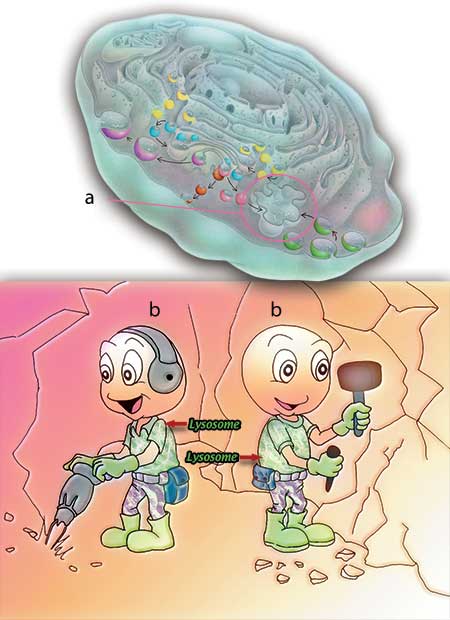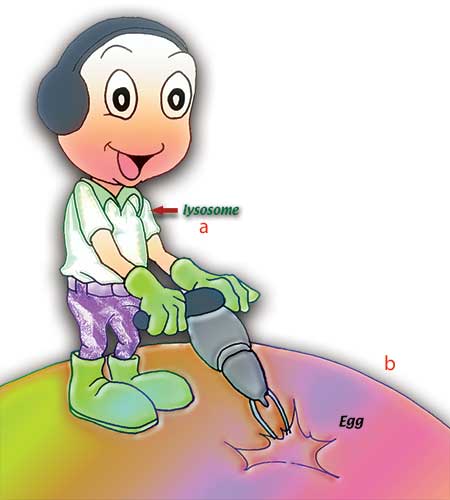7. The Lysosomal Enzymes That Purify the Body
Over the course of a day, many processes of which we are totally unaware take place in our bodies. Our cells carry out these processes flawlessly. Inside these 100 trillion or so cells, there are many structures that know their duties very well. Some generate energy, others proteins, while still others engage in transportation or are used as storage depots.
One of these structures in the cell is the lysosome, which can be described as the cell's grinding machine. Thanks to the enzymes given off by this organelle, a number of degradation processes take place in the body. The enzymes released by lysosome destroy cells that no longer serve any purpose. Besides breaking down or puncturing the membrane surrounding a cell's structure, they also destroy down certain cells that constantly grow inside the body.
 |
| a. Lysosomes inside the cell. |
| Figure 37: Lysosomes break down useless elements by serving as the cell's waste-disposal system. |
This degradation process that lysosome performs is of enormous importance to the body (Figure 37). As the baby develops in a pregnant woman, for example the womb expands many times larger than its original, normal size. This is essential for a healthy baby to be born. However, after the baby is born there is no further need for the womb to be so capacious, this excessively expanded organ now needs to be returned to its former size for the health of the body. The lysosome enzymes help carry out this process. When the birth process is finished, certain cell lysosomes are alerted and, since they have an excellent knowledge of their jobs, they immediately begin secreting the necessary enzymes, which rapidly shrink the womb to 1/40th of its former size in ten days following the birth. The womb thus begins to revert to its former dimensions (Figure 38).
There are also lysosome enzymes in the head portion of sperm cells. Sperms use these enzymes to degrade—and thus, to pierce—the microscopic protective sheath surrounding the egg, and allow the sperm to enter in and achieve fertilization. (Figure 39)
 |
| a. Mother's womb |
| Figure 38: The lysosome enzyme reduces the size of the womb by 1/40 in 10 days after birth, helping it to begin returning to its normal size. |
As can clearly be seen from these examples, every mechanism in your body works in such a way as to complement the others. In addition to the system that permits the womb to grow and swell during pregnancy, there is also another one that returns it to its former state. Similarly, an enzyme that can dissolve the sheath protecting the egg has been especially located inside the head of each sperm.
Yet Darwinists have become so far removed from reason and logic that they can even claim that this interconnected system arose as the result of various coincidences—and then continued to function in its perfect manner. That these mechanisms, with their perfect workings, function in harmony with the systems in the body as a whole is just one of the proofs of the flawless nature of God's creation.
In Surat al-An'am God states that:
That is God, your Lord. There is no god but Him, the Creator of everything. So worship Him. He is responsible for everything. (Surat al-An‘am, 102)
 |
| a. Lysosome |
| Figure 39: Lysosome enzymes, with their ability to break down organic substances, enable the sperm to pierce the sheath that protects the egg and enter to fertilize it. |
- Introduction
- 1. Monitors That Control the Level of Fluids in the Blood
- 2. The Body's Impeccable Security System
- 3. Mother's Milk and the Hormone Oxytosin
- 4. Calcium Measurers
- 5. The Sugar Factory
- 6. Emergency Assistance The Hormone Adrenaline
- 7. The Lysosomal Enzymes That Purify the Body
- 8. The Flowless System That Regulates Blood Pressure
- 9. Growth Hormone
- 10. The Clock in Our Bodies That Never Goes Wrong
- 11. The Miraculous Molecule That Regulates Body Temperature
- 12. An Extraordinarily Delicate Balance
- 13. Hormones That Prepare the Way For the Baby -1
- 14. Hormones That Prepare the Way For the Baby -2
- 15. The Hormones in the Male Reproductive System
- 16. Other Properties of the Hormone Testosterone
- 17. Hemoglobin: The Miraculous Oxygen – Bearing Molecule
- 18. The Communications System in the Cell
- 19. The Messenger Hormone's Journey within the Cell
- 20. Communication Control in the Cell
- 21. Protein Traffic within the Cell
- 22. Chemical Communication in the Nerve Cell
- 23. Nitric Oxide: A Skilled Messenger
- 24. The Endothelial Cell: A Nitric Oxide Production Center
- 25. The Power Station in the Human Body
- 26. The
- 27. DNA Replication
- 28. Repair Enzymes
- 29. Protein Production
- 30. The Final Stage of Protein Production
- 31. The Cell Membrane and 100 Trillion Organized Workers
- 32. What Happens at the Moment of Hearing?
- 33. Blood Clotting
- 34. The Immune System
- 35. The Journey of Vitamin B12
- 36. The Pancreas: The Human Body's Chemist
- 37. Transporter Molecules in the Cell Membrane
- 37. Complement Proteins Responsible for Protecting the Body
- 39. Anti – Acid Formulas Producing Molecules
- 40. The Consciousness Displayed by Egg Cells
- Conclusion
